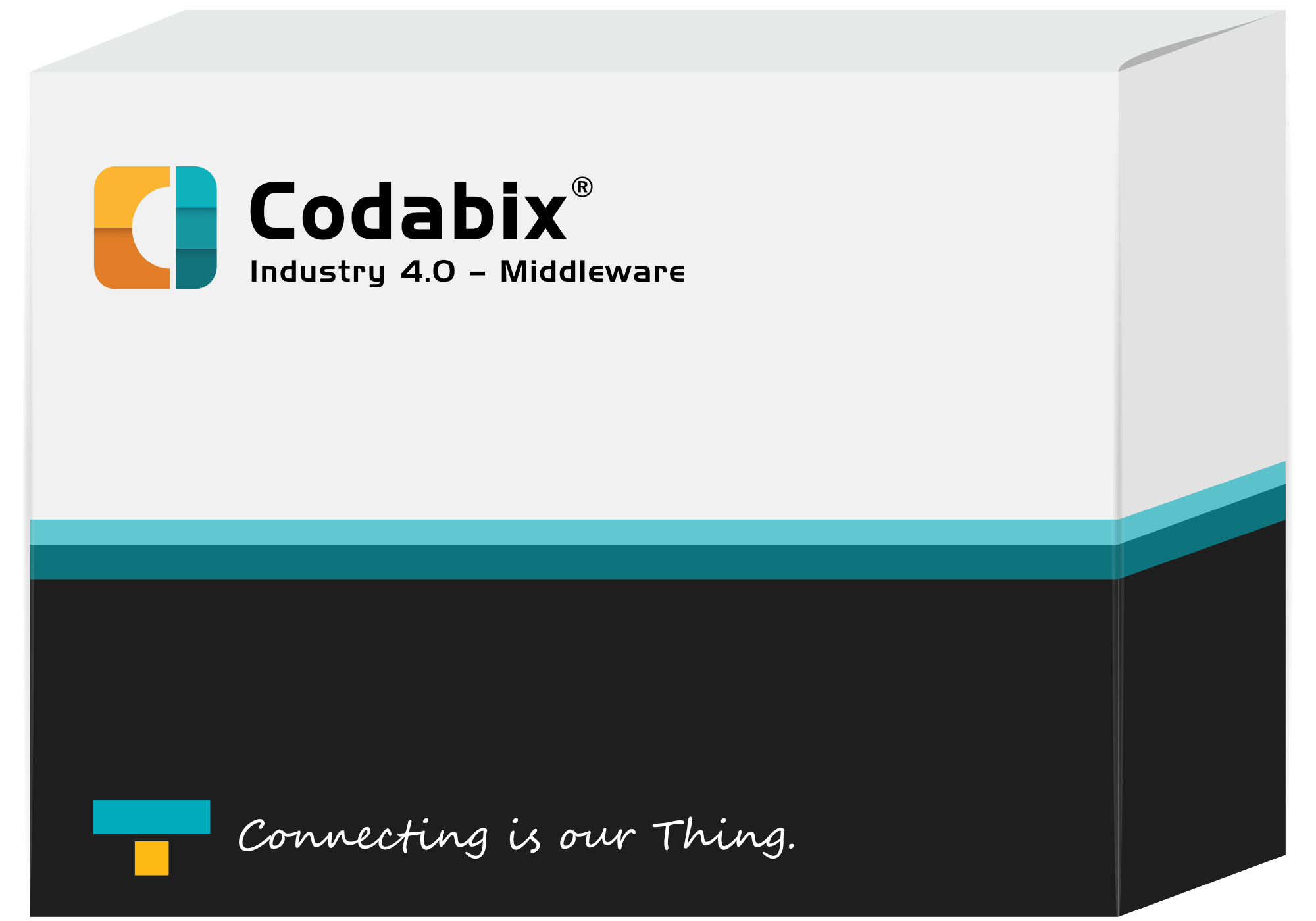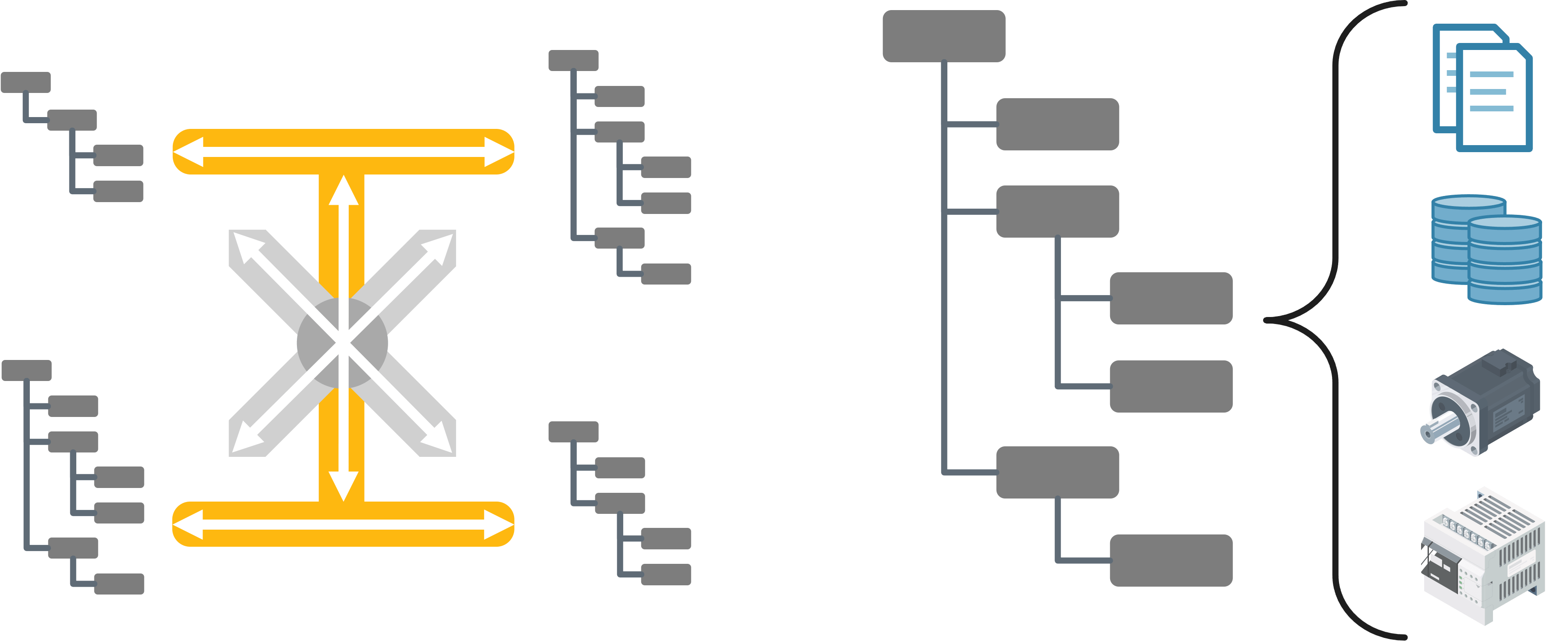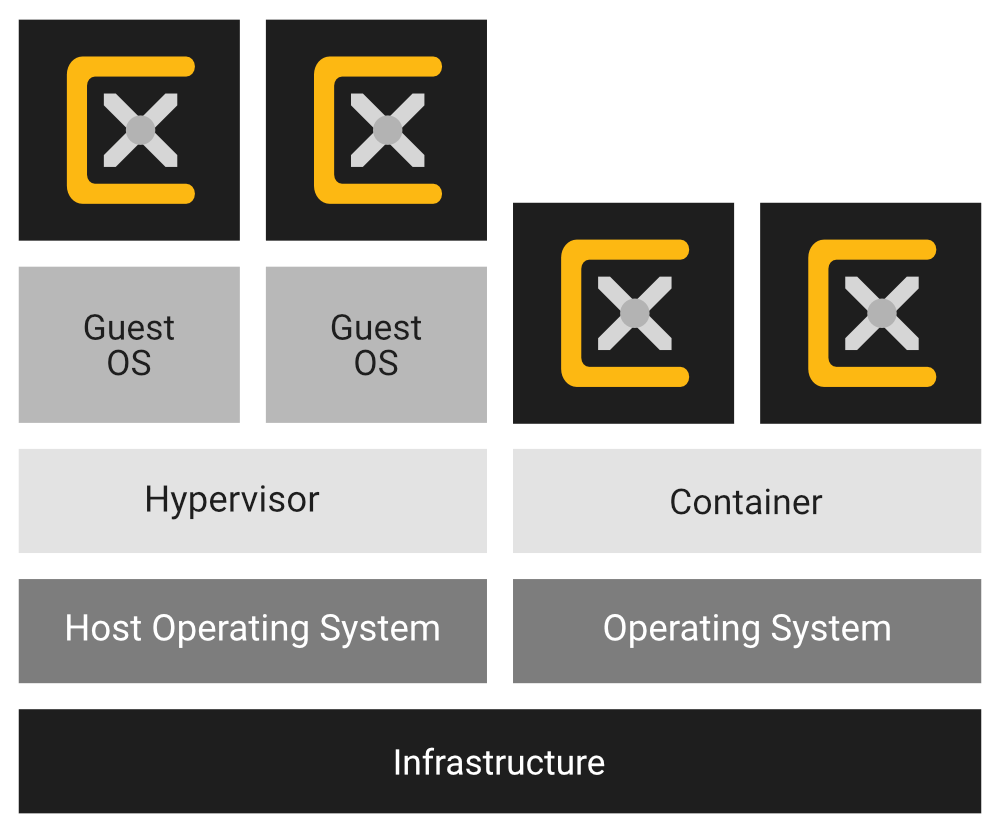Codabix Enterprise
Customised Industry 4.0 middleware

How to use
The customised Industry 4.0 middleware, as individual as your company and your requirements. Concrete requirements need concrete solutions. With the Enterprise version of the Industry 4.0 Middleware, very specific connectivity options can be selected and configured in the required expansion level.
The integrator decides in which scenario the middleware is then used. Regardless of whether the setup is first used as a proof of concept (PoC) in the characteristic Industrial IoT or in the style of the Industrial Edge: every connected heterogeneous participant, whether from the top floor or the shop floor, can be integrated horizontally, vertically and diagonally into the data flow. The setup can be expanded at any time, which means that the middleware can always be adapted to current requirements.

The most important thing is always on board: the integrated OPC UA server and the necessary logic for norming the data according to OPC UA (IEC 62541). The Web 4.0 interfaces of the REST API, REST JSON API and SignalR API, which are also included as standard, can be used for external data processing scenarios.
Each further option of connectivity can be selected and configured in a staggered manner via the respective desired participants and their number. Again, no knowledge of any database dialects, transport protocols or file formats is necessary. Platform-independent, a suitable infrastructure can be selected for the individual scenario or the middleware can simply be connected to the respective protagonists as a container in Docker and Co.
The best:
- No change of hardware and software configuration!
- No licences from Siemens and Co. necessary!
- No follow-up costs and no SaaS commitment!
- No restriction of know-how!
- No change of processes!

Tailor-made Modernisation
"Modern Top Floor"
The use of the middleware can also be topfloor-exclusive. Because requirements for data migration from outdated file formats and legacy databases via ODBC interfaces to modern database systems, simple and structured file formats, can be realised directly with the corresponding plug-ins.
Here, too, the middleware does not understand this as a mandatory "one-off action" and can also carry out the data flow bidirectionally (in both directions). In this way, nothing stands in the way of horizontal integration in the top floor and thus its modernisation.
"Modern Shop Floor"
Classic retrofitting is in the middleware's blood! If a participant from the shop floor is connected, it can be automatically addressed via the corresponding plug-in directly via the integrated OPC UA server. This principle also applies to older protocols and protagonists. In this way, depending on the individual setup, it is possible to "speak" with S5/S7 controllers, with actuators and sensors via serial and RAW socket protocols and many more.
If, for example, the plug-in for the OPC UA client connection is configured, support for OPC Classic (consisting of OPC DA, OPC HDA and OPC AE) is also included. With the OPC UA Server included as standard and integrated in the middleware, an OPC Server is then upgraded to an OPC UA Server.
"Modern Dataflow"
Every non-autonomous and thus every analogue work step between the IT and OT levels leads to delays and inevitably to errors again and again. The vertical integration of these levels closes this gap in automation and unites the top floor with the shop floor.
The best part is that the middleware enables this kind of integration automatically through the use of one or more plug-ins that link participants from the both levels in the software. If this advantage is supplemented with the optional scripting environment, the data flow between the top floor and the shop floor closes. Which thus enables further Industry 4.0 scenarios.
Industry 4.0 Middleware
Depending on the desired setup, a connected participant is automatically data source as well as data sink. Codabix knows the principle of bidirectional communication for every plug-in. Once data points have been defined for the participant, they can be completely freely remodelled, their changes historically recorded and visualised individually – without further options – in the browser via the integrated simple HMI or in user-defined dashboards. Simple, fast and uncomplicated to the Smart Factory.
If the scenarios goes a step further, the middleware can be equipped with additional intelligence. This does not necessarily require a complex data flow scenario. It is also possible to simply log the process data for quality assurance. The steps required for this can also be implemented externally via a separate OPC UA Client, which simply retrieves the data from the standard and integrated OPC UA Server.
(R-)Evolution of Digitalisation
You determine the bandwidth of the participants that can be networked via the middleware. Any additions to your setup that may be necessary at a later date are directly possible and function seamlessly during operation. What is the most favourable setup for your requirements is decided by the individual project – as is the choice of the required platform and infrastructure.
Mechanisms such as access optimisation, normalisation of data according to OPC UA (IEC 62541), standardisation, scaling and historical recording of data are included regardless of the configuration. As a result, the individual setup exclusively decides whether a participant of a certain type can be networked via a certain protocol or not.
Advantages
- Free evaluation without registration
- Easy and fast digitisation
- Industrial reliability
- Qualified support
- Comprehensive documentation
- Regular updates
Characteristics
- Comprehensive OPC UA features
- Guaranteed connectivity
- Headless operation
- Historical data
- Maximum speed
- Interface Modelling
- Plugin System
- Role-based access control
- Configuration import/export
- Node-based data model
- Platform independent
Functional Scope
Codabix in the enterprise version grows with your requirements and can start as a specialised Industrial IoT solution, grow beyond an extended Industrial Edge setup and can be used as an Industrial Data Hub for large corporations. How many homogeneous and heterogeneous participants are started with and how the setup grows with your requirements depends on your own industrial (r)evolution.
The Codabix Engine, the integrated OPC UA Server with support for up to 10 OPC UA Clients and the integrated web server including Web 4.0 interfaces are basically included. The latter can be used via HTTP(S) via REST API, REST JSON API and SignalR.
We will be glad to advise you on the best possible setup for you or on one of our standard industrial middleware versions!
Clustering
If a multiple of the supported number of participants is required, additional "cluster" licences can be purchased to upgrade the standard licence. The range of functions is multiplied according to the number of "cluster" licences. In this way, the step-by-step expansion of the gateway/router is possible without further installations/instances.
Services
If a multiple of the supported number of participants is required, additional "cluster" licences can be purchased to upgrade the standard licence. The range of functions is multiplied according to the number of "cluster" licences. In this way, the step-by-step expansion of the gateway/router is possible without further installations/instances.
Licensing
Unlimited Licence
Once purchased, a licence is valid indefinitely (= unlimited licence lifetime) and allows use without further licence costs (= royalty-free). Shortly before the support expires, it is possible to extend it for at least another 12 months for 15% of the current list price. Updates and new functions can only be obtained with valid support. Support requests can still be submitted, but will be processed on a priority basis depending on their scope. Up to one month before the expiry of active support, we will notify you of the possibility of support renewal. After expiry, a new licence must be purchased for the support renewal. This type of licence can not be used in container environments (such as Docker).
Subscription Licence
Once purchased, a licence is valid for an unlimited period (= unlimited annual licence) and allows use without further licence costs for one year (= annually royalty-free). Shortly before the expiry of the annual subscription (up to one month before), we will notify you about the possibility of extending the subscription. The renewal includes a further 12 months of top level support from our developers as well as updates including new functions. Only with a valid subscription can the application continue to be used and updates and new functions be obtained. Support requests can still be submitted, but will be processed on a priority basis depending on the scope. This type of licence can also be used in container environments (such as Docker).
Features
- Devices via the mentioned ...
Protocols, interfaces and own ways
- Devices and controllers from ...
Allen-Bradley / Rockwell, Beckhoff, Bosch, Mitsubishi, Omron, Siemens, Wago and more
- Systems and machines from ...
Arburg, Engel, Krauss-Maffei, Sumitomo Demag and more
- Components via the interfaces of ...
DELL Edge Gateway, Raspberry Pi, Siemens IOT2050, UniPi, RevolutionPi and more
- Systems and subsystems via ...
CSV, XML, JSON, Excel, Access and more
- Database systems via ...
SQL, SQLite, MySql, MariaDB, PostgreSQL, Microsoft SQL Server, Oracle, Microsoft Access and more
- Integrated scripting environment
own business logic can be implemented online using TypeScript
- Supported protocols
Allen-Bradley or Rockwell EtherNet/IP, Beckhoff ADS, Mitsubishi Melsec, Omron FINS, Omron Host-Link / C-Mode Commands and more
- Supported Siemens protocols
SIMATIC H1, SIMATIC S7, SINUMERIK PL/SL and more
- Supported RAW protocols
I2C, RAW Serial Port, RAW TCP Socket and more
- Supported Standard Protocols
RFC-1006, Modbus TCP, Modbus RTU, MQTT Publisher/Subscriber, OPC UA, OPC Classic (OPC DA, OPC HDA and OPC AE), EUROMAP 63 and more
- Supported interfaces
OPC UA Server, REST API, REST JSON API, SignalR API, HTTP(S) Web Server, Plugins and Scripts
- Supported platforms
Windows, Linux, macOS and Docker
- Other features
Simple HMI and custom dashboard design